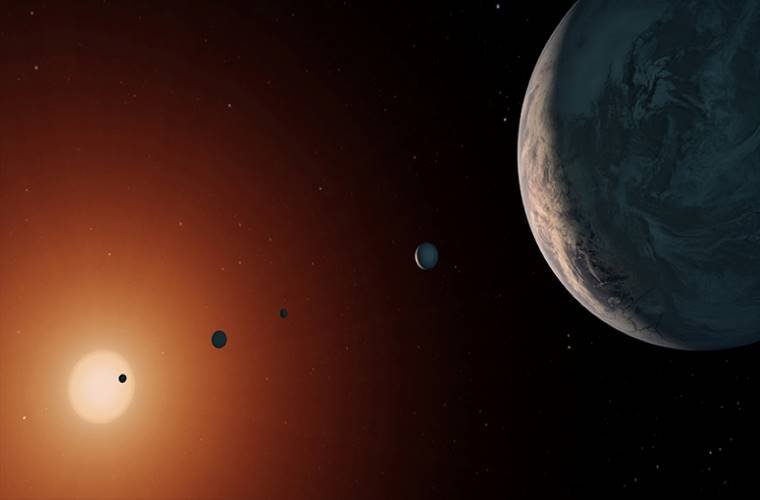According to Elon Musk, SpaceX’s Starship will propel humanity to become a multi-planet species, starting with a base on Mars. Following the common advice of real estate agents, we must explore the full inventory before choosing a new home. The considerations should not only involve the potential for liquid water and the nutrients for life-as-we-know-it but also transportation to and from that location.
The Milky Way galaxy alone contains tens of billions of rocky planets in the habitable zone of stars, most of which are red dwarfs with about a tenth of the mass of the Sun. When considering a new home, we must ask how difficult it would be to travel from it to other destinations. In particular, we should compare these travel opportunities to what is available at our first home on Earth near the Sun.
A recent survey of rocky exoplanets around other stars shows that while some have escape speeds lower than Earth’s, others have higher barriers to escape.
Consider, in particular, the red dwarf star TRAPPIST-1, located 40.7 light years away from the Sun, which hosts seven transiting planets with radii in the range of 0.7-1.13 times the Earth’s radius. One of these rocky planets, TRAPPIST-1d, has a planetary escape speed of 7.86 kilometers per second, about 70% of the Earth’s value of 11.2 kilometers per second. The stellar radiation flux impinging on the surface of TRAPPIST-1d is similar to the solar flux on Earth, and could lead to a similar equilibrium temperature if the two planets have similar reflectance.
Given that TRAPPIST-1d resides in the habitable zone of its host star, a technological civilization could have been born there. In that case, the TRAPPIST-1d space program would find it easier to reach the outside world with a spacecraft that carries half the kinetic energy needed for Starship on Earth. These escaping rockets could provide an efficient transport system between the seven planets of the TRAPPIST-1 system, which are densely packed between orbital radii in the range between 1.1%-5.9% of the Earth-Sun separation, with orbital periods of 1.5-19 days.
The orbital time for TRAPPIST-1d (equivalent to a year for Earth) is 4.05 days. Even though the host star is intrinsically 8.3 times smaller in size than the Sun, it is looming 5.5 times larger on the planet’s sky than the Sun looks from Earth because of the proximity of the planet to the star. The star TRAPPIST-1 has 9% of the solar mass and 12% of the solar radius, making it 52 times denser than the Sun. Its surface temperature is 2,516 degrees Kelvin or 43.5% that of the Sun, and its luminosity is 0.05% of the solar luminosity. Since it burns its nuclear fuel slowly, TRAPPIST-1 can live up to 7 trillion years, about 600 times longer than the Sun.
Even though escaping the habitable TRAPPIST-1d is easier than escaping Earth, reaching interstellar space from its orbit around its host star is far more challenging. This is because the planet TRAPPIST-1d is 45 times closer to its star than the Earth is to the Sun. As a result, the escape speed from the orbital radius of TRAPPIST-1d to interstellar space is 85 kilometers per second, a factor of two larger than the corresponding value for Earth.
The Russian scientist Konstantin Tsiolkovsky derived in 1903 the amount of fuel needed to propel a rocket to a desired terminal speed and found that the needed fuel mass grows exponentially with terminal speed. For the liquid oxygen/methane fuel used on Starship with an exhaust speed of 3.21 kilometers per second (equivalent to a specific impulse of 327 seconds), the fuel mass needed for escape to interstellar escape from the orbit of TRAPPIST-1d is about a million times larger than it is for Earth.
In other words, a technological civilization on TRAPPIST-1d would need about a million times more fuel than we needed to launch our five interstellar probes: Voyager 1 and 2, Pioneer 10 and 11 or New Horizons. We should be grateful to our privilege to have an interstellar space program based on chemical rockets thanks to the parameters of the Sun and the Earth. This is a lucky coincidence of the circumstances.
Our interstellar probes will be defunct and constitute space trash once they exit the outer boundary of the Oort cloud and venture into interstellar space in about 10,000 years. The above-mentioned numbers suggest that we are more likely to find in our backyard chemically-propelled trash from extraterrestrial civilizations than were born near Sun-like stars rather than dwarf stars.
Given the depth of their gravitational pit, intelligent alien species near dwarf stars may use alternative means of propulsion, such as light sails, nuclear engines, or novel orbits with gravity assist.
Avi Loeb is the head of the Galileo Project, founding director of Harvard University’s – Black Hole Initiative, director of the Institute for Theory and Computation at the Harvard-Smithsonian Center for Astrophysics, and the former chair of the astronomy department at Harvard University (2011-2020). He is a former member of the President’s Council of Advisors on Science and Technology and a former chair of the Board on Physics and Astronomy of the National Academies. He is the bestselling author of “Extraterrestrial: The First Sign of Intelligent Life Beyond Earth” and a co-author of the textbook “Life in the Cosmos”, both published in 2021. His new book, titled “Interstellar”, was published in August 2023.

